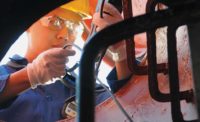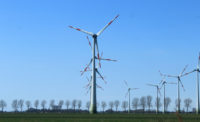When one thinks of confined space work, one might visualize a worker climbing down or being lowered down into a manhole. Confined space work is not limited to descending into compact areas, but regardless of the manner of entering these areas, it’s important to know that specialized equipment that goes above and beyond the function of ordinary fall protection will be required to keep your personnel safe.
Definition of confined space
Confined space is defined as a working environment with limited or restricted means of entry and exit — specifically, an access point less than 24” in diameter. In many instances, personnel working in confined spaces are also subjected to increased risk of entrapment, engulfment, and hazardous atmospheric conditions.
All job sites with ongoing confined space work environments must also be equipped with appropriate OSHA-approved rescue equipment in the event that an employee is not able to exit the hazardous area without assistance.
All job sites with ongoing confined space work environments must also be equipped with appropriate OSHA-approved rescue equipment in the event that an employee is not able to exit the hazardous area without assistance. Emergency services, 911, and/or medical assistance should always be called in the event a fall incident occurs, but that does not relieve the employer of their duty to have equipment on-hand to perform self-rescue methods before first responders arrive at the scene. Examples of confined space work environments include but are not limited to, underground vaults, tanks, storage bins, hoppers, ingot pits and diked areas, vessels, silos, and other similar areas.
Unique hazards in confined spaces
Since confined spaces can range from a variety of environments, it’s important to make sure these areas are as safe for workers to enter and perform tasks as any other area in the workplace.
Workers might have to wear respiratory protection gear along with their fall protection gear and other personal protective equipment (PPE) to safely perform their work in a normally toxic environment. It is important to don all PPE with your fall protection gear outside the confined space to ensure the respirator does not interfere with the fall protection harness, and vice versa. Gas detection monitors or other air sampling equipment might be necessary to carry into the confined space if certain chemicals or compounds are present that could reach immediately dangerous to life or health (IDLH) conditions. OSHA does not allow workers to enter confined spaces without attendants present outside the area with the simple, but imperative, job of monitoring the well-being of workers inside the confined space.
Choosing the right equipment for confined space work
A common scenario for confined space work is a worker that must climb or be lowered down into the area to perform their work. If the worker is more than four feet above the next lower level when starting their descent, they must don fall protection equipment to protect them in case they slip & fall while climbing down or their descent equipment fails. Tripods or davit arms can provide an anchor point to attach a user’s connection device, which is likely a Self-Retracting Lifeline (SRL), and can also accommodate a descent device, like a winch, for lowering work material or personnel.
However, if a user is being lowered into the confined space with a descent device, they must utilize another attachment point on their harness besides the dorsal d-ring on their back for the winch. ANSI Z359 only allows one gated connection (snaphook, carabiner, etc.) per d-ring on a user’s body harness. In this case, the worker has the option to attach to a chest d-ring on the front of the harness or utilize a spreader bar with their descent device that requires a d-ring installed on the top of both shoulder straps of the harness. Both systems have their advantages and disadvantages, and employers should ensure that the provided harness to their crew contains the necessary d-rings required to perform confined space work.
Ensuring their harness has the necessary d-rings installed before beginning work should be part of a user’s pre-task analysis and pre-use equipment inspection. Depending on the standard equipment provided, confined space work might require another harness to be purchased that contains the necessary hardware installed.
Rescue methods in confined spaces
In regards to rescuing a fallen worker in confined spaces, an SRL-R (“-R” for rescue) is recommended, as opposed to a standard SRL. SRL-R units contain winch capabilities to help raise or lower the worker to safety in the event of a fall. However, it should be noted that winch capabilities on an SRL-R are for emergency rescue use only and are not permitted for regular material or personnel loading. Once an SRL-R’s winch function is activated, it can no longer be used for fall protection until serviced or recertified by the manufacturer or certified repair center.
Misusing fall protection equipment is not only an extremely bad practice, but it goes against OSHA’s requirement to follow manufacturer instructions. Unintended operations from the equipment’s original purpose will often violate the ANSI code as well.
Training for confined spaces
Standard fall protection trainings should cover the basics of most equipment used in confined space, but every team should incorporate their personal equipment into trainings to ensure crews are familiar with the equipment well before entering one. Too often are crews unfamiliar with confined space equipment because it might be infrequent work, but confined spaces tend to have a greater risk of incidents occurring than typical working-at-height operations.
It is important to train confined space crews as many times as necessary to ensure they are familiar with the operation of this specialized equipment and will be able to promptly begin self-rescue protocols while awaiting emergency services, in the case of a fall.
Conclusion
Don’t feel confined with your options next time your crew needs to work in a confined space. The technology is available and there are many resources available specifically tailored to many unique work environments to provide OSHA-compliant confined space rescue equipment to assist employees who are unable to exit dangerous areas.



